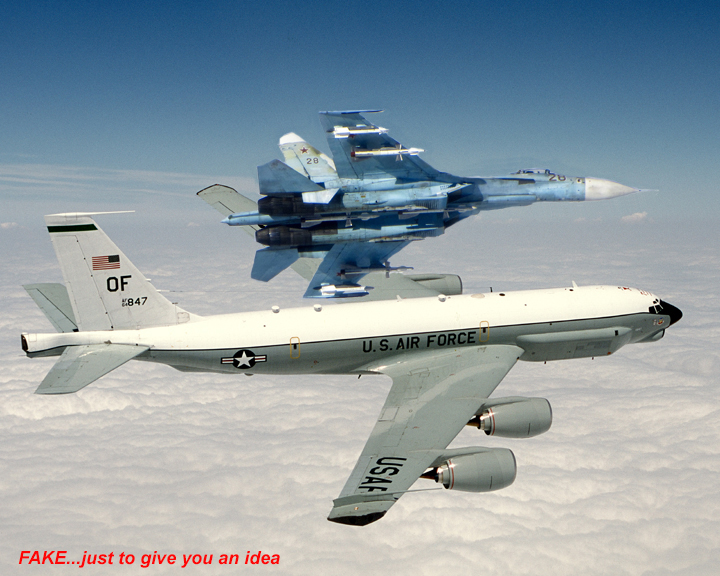An “unsafe and unprofessional” intercept over the Baltic Sea.
On April 14, a U.S. Air Force RC-135U Combat Sent electronic intelligence gathering aircraft flying a routine mission (in international airspace) over the Baltic Sea was intercepted by a Russian Su-27 in “an unsafe and unprofessional manner,” Navy Capt. Danny Hernandez, U.S. European Command spokesman told the CNN.
According to EUCOM, the Flanker began the barrel roll from the left side of the U.S. RC-135 and went over the top of it to end on the right side of the aircraft, an aggressive maneuver (not compliant with the international standards) that brought the Russian jet dangerously close to colliding with the Combat Sent.
The episode comes few days after Russian Su-24s performed several low passes over a U.S. destroyer in the Baltic Sea, and it’s only the last in a long series of tense close encounters between American spyplanes and Russian fighters in the skies across the world.
On Jan. 25, 2016 a U.S. RC-135 intelligence gathering jet was intercepted by a Russian Su-27 Flanker fighter jet over Black Sea: during the interception, the Su-27 made an aggressive turn that disturbed the controllability of the RC-135.
On Apr. 7, 2015 another Su-27 flew within 20 feet of an RC-135U, over the Baltic Sea.
On Apr. 23, 2015 a U.S. Air Force RC-135U Combat Sent performing a routine surveillance mission in international airspace over the Sea of Okhotsk, north of Japan, some 60 miles off eastern Russia was intercepted by a Russian Su-27 Flanker that crossed the route of the U.S. aircraft putting itself within 100 feet of the Combat Sent.
Actually, some “reckless” intercepts on U.S. spyplanes have been conducted by Chinese pilots as well.
In 2014, a Chinese Flanker made a barrel roll over a U.S. Navy P-8 maritime surveillance plane 135 miles east of Hainan Island, a spot of a far more dangerous close encounter of another U.S. electronic surveillance plane with the Chinese Navy back in 2001.
On Apr. 1, 2001, a U.S. Navy EP-3E with the VQ-1, flying an ELINT (Electronic Intelligence) mission in international airspace 64 miles southeast of the island of Hainan was intercepted by two PLAN (People’s Liberation Army Navy) J-8 fighters.
One of the J-8s piloted by Lt. Cdr. Wang Wei, made two close passes to the EP-3 before colliding with the spyplane on the third pass. As a consequence, the J-8 broke into two pieces and crashed into the sea causing the death of the pilot, whereas the EP-3, severely damaged, performed an unauthorized landing at China’s Lingshui airfield.
The 24 crew members (21 men and three women), that destroyed all (or at least most of ) the sensitive items and data on board the aircraft, were detained by Chinese authorities until Apr. 11.
Anyway, not only have U.S. aircraft been harassed during intercept missions. Here are just a few examples.
On Sept. 13, 1987, a RNoAF P-3B had a mid-air collision in similar circumstances with a Soviet Sukhoi Su-27 Flanker over the Barents Sea.
In Apr. 2012, whilst flying over the Barents Sea on a routine mission, a Norwegian P-3 Orion almost collided with a Russian Air Force Mig-31 Foxhound that had intercepted the patrol aircraft.
On Jul. 16, 2014, between Gotland and Latvia, a Russian Su-27 Flanker, armed with 6 air-to-air missiles, intercepted one of the two Swedish ELINT jet, and flew as close as 10,7 meters of the spyplane.
Top image: not an actual photo but a composition we made using Wiki images
















